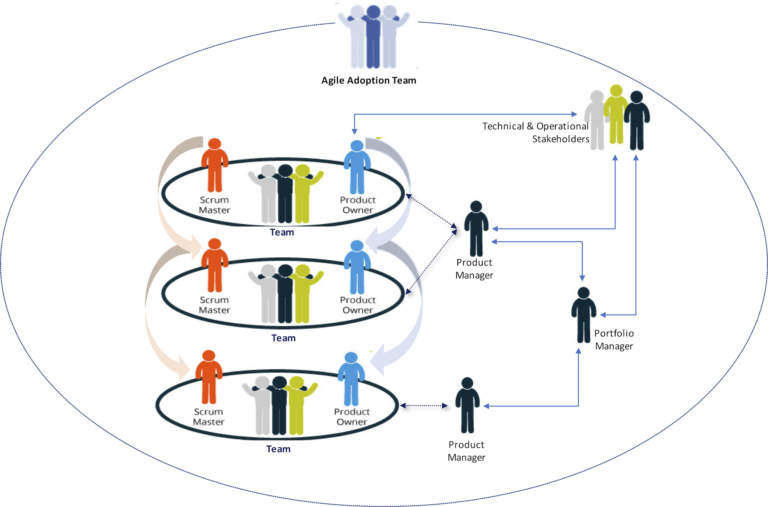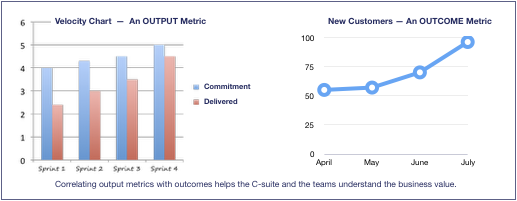
In our recent white paper titled, Achieving Agile at Scale, we discuss some of the challenges organizations face in terms of product and technology, as well as business leadership. It’s an important topic because it reflects reality for many companies. The hard work is in the day-to-day efforts, and when facing tough challenges, people want practical answers that help them accelerate implementation and become more Agile in the process.
For many, the business and leadership challenges are the toughest. But, to really solve these business challenges means the difference between “doing” Agile and “being” Agile. So, let’s walk through a few common ones we’ve encountered and let me share our thoughts on solving them.
Challenge #1: Excessive hierarchy and decisions are only made by top-down senior management
When we hear about this challenge, what we typically see is an organization that has islands of Agile teams operating, while the business side of product management continues to function the old way. The point of becoming Agile is to help organizations deliver real value to customers quickly. For that to happen, the business needs a reasonable team structure that is empowered to drive collaboration, communication and orchestration within teams, across multiple teams and cross-functionally. The following structure is one we believe fosters the right information flow across all the right stakeholders.
 Collaboration & Communication Structure for Agile at Cale
Collaboration & Communication Structure for Agile at Cale
To enable this team structure, it’s important to have the right roles defined that facilitate the business side collaborating with Agile teams. For example, the role of the Product Owner, who works with (1 or several teams) to make decisions on priorities. The Product Owner is key because they help maintain alignment and provide an important connection to non-team cross-functional stakeholders—so everyone is moving forward together and in the right direction. Benefit can come from a number of other roles acting as cross-team contributors in areas such as architecture, design, quality, operations and finance. All of this encourages a mesh network of teams that are well coordinated. In addition to a good team structure, the organization needs to have the will to change from old command-and-control methods to a fully supported, effective team. This comes down to cultural change, which is hard to do because it requires buy-in from executives and all stakeholders across the organization. Without the right culture, companies will find themselves just doing Agile versus really being Agile.
Challenge #2: Disconnect with business objectives and Agile teams are solely focused on delivering technology
An anticipated benefit of Agile is accelerated delivery. In today’s competitive markets, the business imperative is all about customer experience. So, it’s important to recognize that while achieving the speed of Agile is great, the benefit should be traceable back to customers and reflected in business performance outcomes. This is how you connect the dots between the investment in transforming to Agile at Scale and demonstrating the benefits and ROI to senior management.
A common symptom of this challenge is when Agile teams focus on measuring progress only in the form of output, such as number of sprints, velocity etc—parameters that measure productivity. These data points make teams feel good, but fail to answer the business questions executives have, which can undermine their perception that Agile is adding value to the company’s growth overall. Outcome analytics speak to product lines, business lines and the C-suite because they show the value of Agile in terms that relate to the customer experience and business performance—such as, more sales, or more customers, or more sales per customer, longer customer retention, faster time to resolution, lower abandonment on customer journeys and so on.
A best practice is to correlate Agile outputs with business outcomes. For example, an increase in the number of production releases (output) has led to an increase in incremental sales to existing customers (outcome). One of my recent blogs titled, “How Analytics Measuring Output and Outcome Bring Value to Scaling Agile” discusses the topic further and provides some examples.

Challenge #3: Externally driven culture change, meaning outside groups establish new methods without involving existing Agile teams
It can be particularly challenging when management unexpectedly brings in a new consultancy to help the organization be Agile. When we’ve encountered this, we advocate an initial discussion to help establish a collaborative effort between the “change agents” and the teams. Rather than perceiving it as a “command-and-control” move by management, we emphasize the objective is to facilitate and enable a company-wide Agile ecosystem that operates true to the principles of Agile. In many cases the new group can add substantial value by facilitating consistent communication across teams and stakeholders on matters related to roles, training, use of uniform methods and tools, investment and so on. The point is to convert the resource into a value-add contributor so everyone is aligned.
We also believe (and encourage during situations such as this) that it is a best practice that introduction of adjustments to methods and tools remain driven by the teams themselves. Things run more smoothly when change is incremental and iterative—based on team consensus.
Challenge #4: Disconnect with product management, in which product management does not partner with Agile teams
Frequent communication and collaboration are really important. A best practice we recommend that can help facilitate good communication and collaboration, is delivering (sprints) releases frequently for review. The interaction that comes via these reviews will generate empirical data (from product management and possibly customers) that underpins the feedback loop necessary for continuous improvement.
There is another aspect to this challenge, and that is defining the appropriate new roles, as well as revising existing roles so everyone understands how they “fit” into an Agile environment and how they operate together. It’s best if this is completed at the beginning of an Agile adoption effort, but frequently comes about as part of the learning curve. In either case, it’s valuable to take the time to get this right. And, in our experience, it can be facilitated when companies form Agile adoption groups to help provide the day-to-day leadership and training needed to enable transition.
Challenge #5: Non-Agile outsourced relationships, in which those organizations are measured by rigid deliverables and metrics that interfere or undermine Agile results
This is a tough one, and typically happens in large enterprises where business processes such as IT, are outsourced and suddenly in conflict with an organization trying to achieve continuous integration and delivery. Because companies must innovate quickly to survive (Digitally Transform) and Agile is integral to that transformation, the days of annual contracts based on global SLAs is facing change.
Newer Agile-compatible thinking around contracts and relationships are emerging so infrastructure and support keep pace with development. Some examples include moving away from specifying fixed costs, effort and milestones for pre-planned deliverables; in order to adopt measures consistent with the flexibility and iterative nature of Agile values.
We know this challenge is difficult to overcome. It takes time and requires involvement from executives and other stakeholders—on both sides, the vendor and the company—to review contractual changes and financial impact in order to make sound business decisions. This challenge in particular may underscore why scaling Agile in enterprise environments is “still out of reach for many” as pointed out by industry analysts. And, it exemplifies the critical importance of culture change. In our opinion, not every department needs to become Agile, but everyone does need to think Agile in order to fully gain the benefits of Agility.
Despite the Challenges, Agile is Valuable for Business
The key to remember is that, for any organization, adopting Agile at scale is NOT an engineering project or a development process. It is hard work and forces new behaviors and ways of working. It’s a complex undertaking and creates many challenges. At the heart, Agile reflects a set of values that underpin how an organization shall interact, operate and grow as it competes in the marketplace. Agile promotes the kind of behavior changes essential to successful digital transformation—which in today’s world is key to remaining competitive and relevant to your customers. Remember, every transition has challenges, but those challenges can be overcome when the whole organization supports the endeavor.
The subject of Agile is important to us at Encora, and we leverage our experience and expertise to help our customers innovate and grow. As always, if you have any questions or comments, we would enjoy hearing from you.


